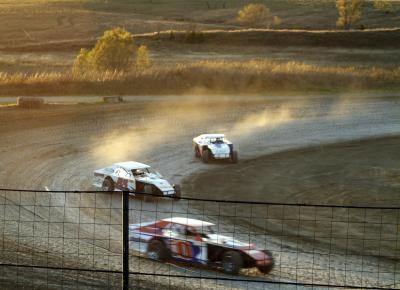
Modern race cars have a front and rear suspension that can lead forward or trail backwards. In other words, the center-line of the front and rear axles can be moved forward or backwards. That presents the problem of what reference points are used to square the chassis and align the wheels. Older late-model race cars used a stock front lower control arm that was fixed. This created a reference point to square the chassis. Some cars used the same right front lower control arm on both the left and right front. This moves the left-front wheel back and allows for more weight on that wheel.
Adjust the ride height of the late-model race car on a level concrete surface. The ride height may be dictated by the rules. A paramount rule for pavement late models is to keep the inside mounting point centers of the front lower struts or A-arms level with the center ball joint pivot. Compound the level geometry with a rule to keep the race car as low as possible.
Place the car on four large wheel boxes, one under each wheel. A wheel box is an aluminum box or equivalent that is about eight inches off the floor. The boxes are used to raise the car off the concrete floor so adjustments can be made under the car.
Locate any frame rail that runs parallel with the center line of the car. If there is no parallel frame rail run a tight and accurate string tied to a jack stand in the front and rear of the race car.
Position a drywall square on the parallel frame rail or very carefully against the string under the middle of the car. Mark several points along the perpendicular blade of the drywall square under the middle of the race car chassis. Make sure the square is accurate. Mark a fine line with a marker, then double- and triple-check the measurements and make final marks using a sharp prick punch. Drill the prick punch marks to make permanent marks under the center of the race car, using a small drill.
Clamp an aluminum angle under the middle of the car, aligned with the very edge of the drilled holes. Hang two plumb bobs over the rear-end housing just inside the wheels on the right and left side. Let the plumb bobs hang so they are about an inch off the floor. Clamp two plumb bobs onto the angle that will be used as the reference measurement points. Clamp them to the angle about as far apart as the plumb bobs hanging over the rear axle tubes.
Remove the grease fittings on the front lower struts or A-arms, and replace them with the drilled grease fittings with a string through the drilled hole and plumb bobs on the end of the strings.
Measure from the rear end plumb bobs to the plumb bobs clamped to the reference angle. Be sure to add or subtract half the diameter of the rear-end housing, depending on whether the bob strings hang over the front or rear of the rear-end housing. Use these measurements to square the rear-end housing.
Make another measurement from the front plumb bobs to the bobs clamped on the reference angle. Adjust the struts to square the front end of the race car.
Run a string from a jack stand in the right-front of the car on the outside of the tire to a jack stand at the right rear of the car on the outside of the tire. Use this string to align the rear-wheel tracking with the front tire, as desired.
Check all the measurements several times, especially if any adjustments are made, to be sure they are accurate. You win races by paying close attention to detail here. Be sure the wheel base measurement of the race car is sufficient to satisfy the track rule book.